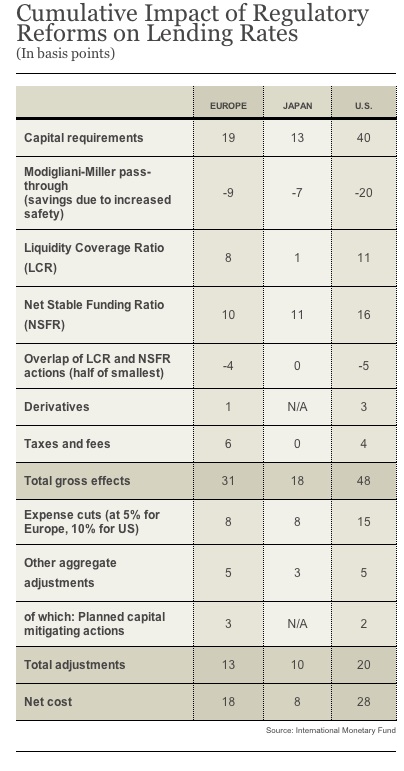The IMF has released a paper called “Assessing the Cost of Financial Regulation” authored by Douglas Elliott, Suzanne Salloy, and André Oliveira Santos. They claim the costs of new regulation are lower than many other reports would suggest, disputing some of the work put out by the industry along the way. Interesting enough, the biggest slug of net increased costs will come from liquidity requirements – the LCR and NSFR to be exact.
An article in Institutional Investor posted a chart that summed up the incremental costs as well as offsets. While increased capital requirements had the biggest absolute numbers, they also had the most substantial offsets. Those offsets come from the expectation that greater capital would make the banks seen as less risky and lower their cost of capital. We are of the “seeing is believing” school concerning the accuracy of that statement, but that discussion is for another time.The question for today is whether the industry can really expect higher or lower costs as the result of new regulation.
The study showed that the LCR would add 8bp, 1bp, and 11bp to the lending rates charged by banks in Europe, Japan, and the US respectively. The NSFR would add 10bp, 11bp, and 16bp respectively. However the authors note that there is overlap between the LCR and NSFR, reducing the overall cost. Net, the liquidity requirements would add 14bp, 17bp, and 22bp to bank lending rates in Europe, Japan, and the US respectively. In our neck of the woods – repo and securities lending – those look like big bumps up, especially relative to the current short-term benchmarks. In all fairness, the study did say that banks would be able to offset some of these costs, mentioning cost cutting as one path. Gee thanks. Also, the numbers are “long run” projections. At the risk of going over our snarky quota, we all know what Keynes said about the long run.
A copy of the chart is below.
The IMF report says that banks that aren’t compliant on their LCR and NSFR targets would have to
- Increase the length of liabilities
- Raise capital
- Shorten the maturity of assets
- Switch to higher quality assets
- Shrink, in combination with other actions
And “…Under normal circumstances, each of the potential adjustment actions by banks would reduce profits. When there is a normal upward-sloping yield curve, longer-term liabilities will cost more than shorter-term ones and shorter-term assets will earn less than those of longer term. Capital, for its part, is more expensive than other funding sources. Similarly, higher-quality assets virtually always yield less than lower-quality ones, since risk aversion by investors means that riskier assets must generally pay higher returns. Finally, shrinking a bank’s book usually means reducing otherwise profitable business…”
The authors also say that the liquidity requirements will put a crimp on maturity transformation, “…Maturity transformation is not just an activity from which banks derive profits; it also plays an important economic role… The Basel III liquidity requirements would almost certainly reduce maturity transformation to some extent…”
Everyone has his or her own numbers and spin on the impact of regulation; this IMF paper seems to us to be the latest iteration. One thing is for sure: the requirement will cause pain and require substantial changes in business models, especially in the securities finance world.
A link to the IMF paper is here.
A link to the Institutional Investor article is here.


